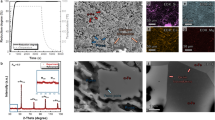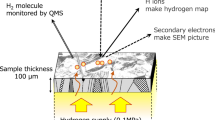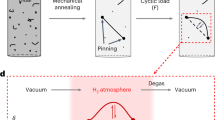Abstract
RECENT measurements of hydrogen diffusion-rates in α-iron by Johnson and Hill1 gave approximately 2 × 10−7 cm.2/sec. for the value of D at room temperature; and in steel by Frank, Lee, and Williams2 gave approximately 1 × 10−7 cm.2/sec. Johnson and Hill measured re-emission of hydrogen from cylinders previously soaked in hydrogen at high temperatures and pressures, while Frank et al. used a mass spectrometer to measure the emission of hydrogen and deuterium from thin sheets. Frank, Swets and Fry3, observing the build-up of hydrogen permeating through thin sheets of steel, obtained for D at room temperature values about an order of magnitude higher.
This is a preview of subscription content, access via your institution
Access options
Subscribe to this journal
Receive 51 print issues and online access
$199.00 per year
only $3.90 per issue
Buy this article
- Purchase on SpringerLink
- Instant access to full article PDF
Prices may be subject to local taxes which are calculated during checkout
Similar content being viewed by others
References
Johnson, E. W., and Hill, M. L., Trans. Met. Soc., Amer. Inst. Mech. Eng., 218, 1104 (1960).
Frank, R. C., Lee, R. W., and Williams, R. L., J. App. Phys., 29, 898 (1958).
Frank, R. C., Swets, D. E., and Fry, D. L., J. App. Phys., 29, 892 (1958).
Fireman, E. L., and Zahringer, J., Phys. Rev., 107, 1695 (1957).
Author information
Authors and Affiliations
Rights and permissions
About this article
Cite this article
TILLES, D. A Room-Temperature Diffusion Constant for Hydrogen in Proton-irradiated Steel. Nature 194, 1273–1274 (1962). https://doi.org/10.1038/1941273a0
Issue date:
DOI: https://doi.org/10.1038/1941273a0
This article is cited by
-
Meteoritic Tritium and Diffusion in α- and γ-Iron
Nature (1964)
-
Tritium Retention in Iron Meteorites
Nature (1963)
-
Diffusion Today
JOM (1963)



